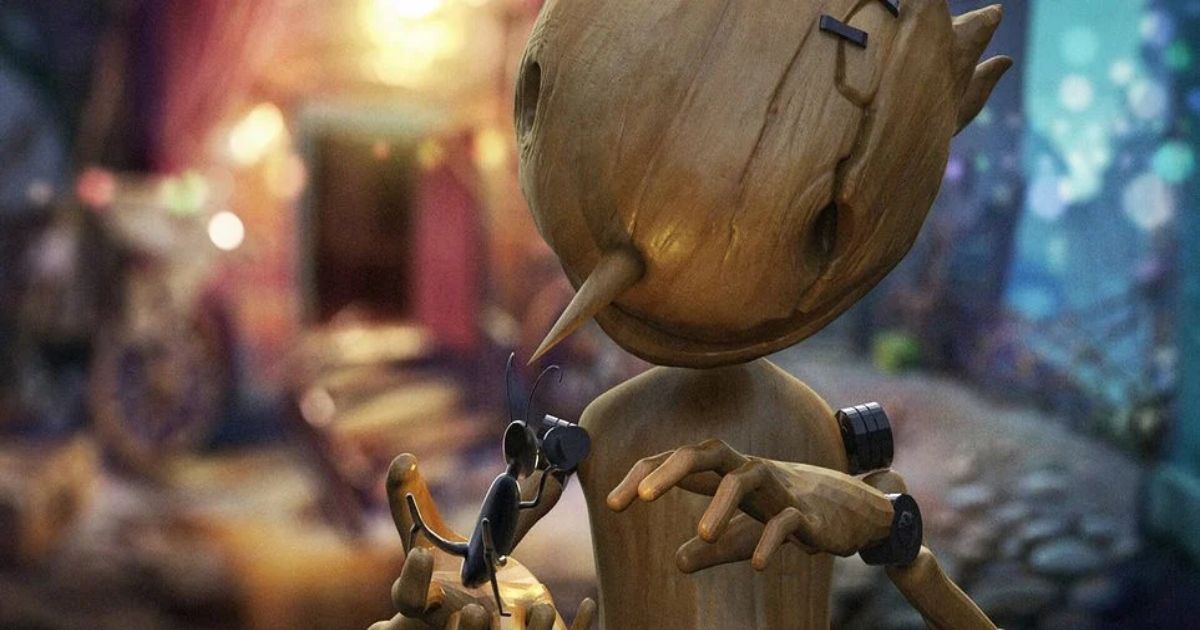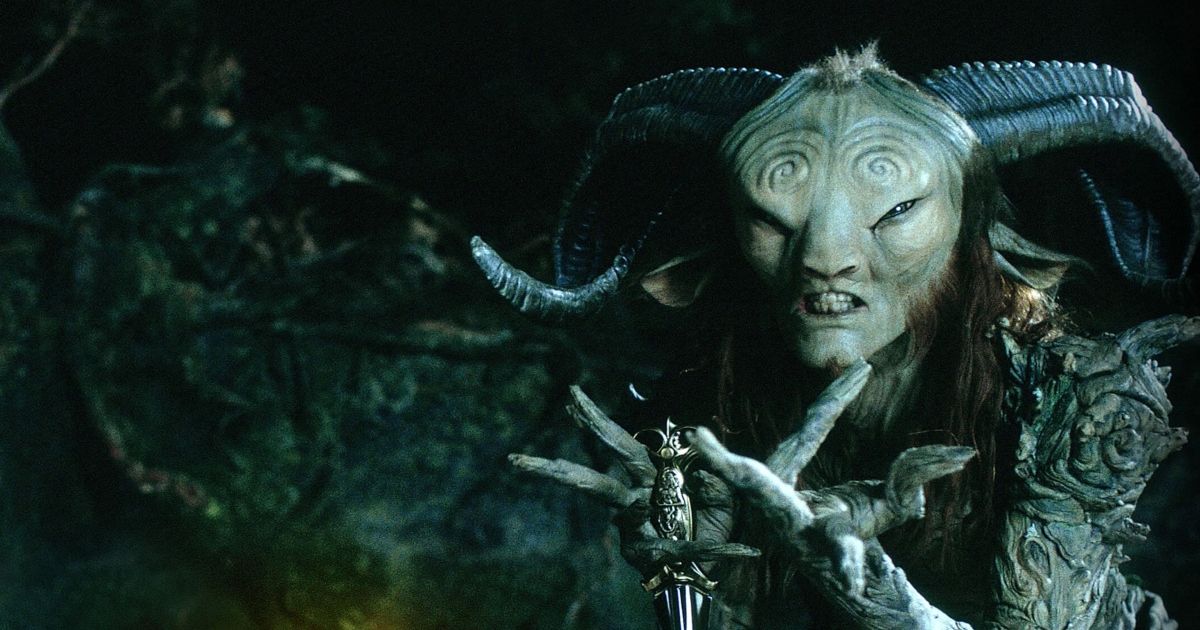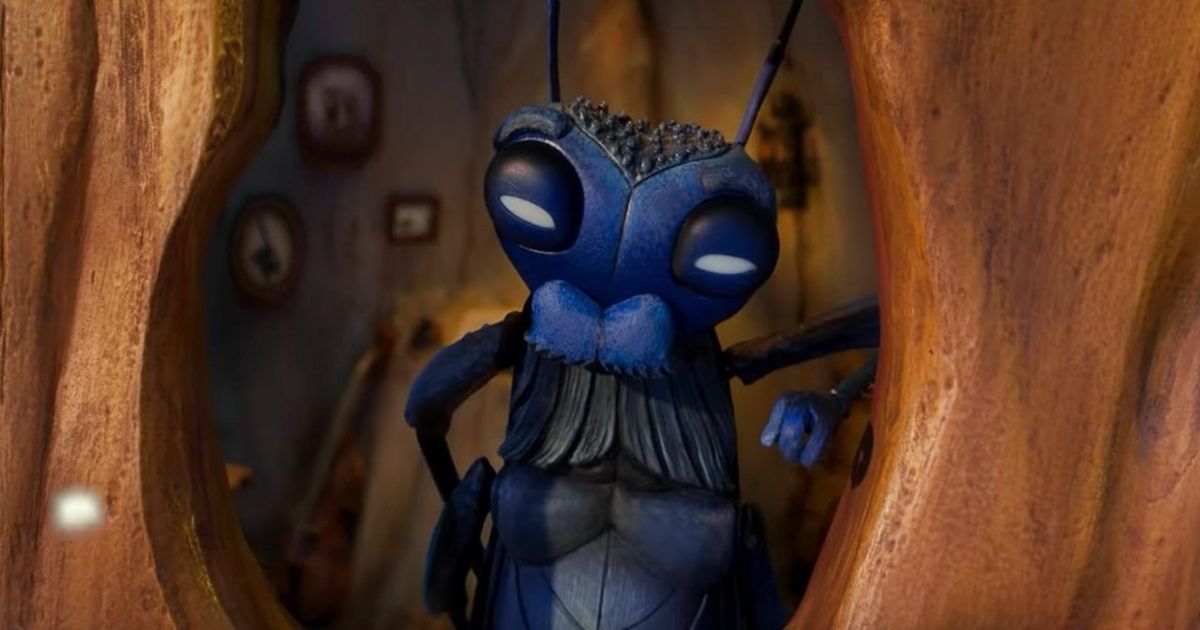2022 will see the release of two major cinematic versions of Carlo Collodi's Italian children's story, The Adventures of Pinocchio -- one co-directed by Guillermo del Toro (with Mark Gustafson) for Netflix, the other directed by Robert Zemeckis for Disney. Both are musicals, both are animated (to varying degrees), and both deal with the timeless tale of a young puppet who learns to be a real boy. But how will the directors' visions differ? Will they be unique enough to draw audiences to the theaters (or streaming sites) twice for the same story? And when the inevitable comparisons are made, which film will come out on top?Both projects have unveiled teaser trailers, and the small tastes audiences have been given differ greatly. Disney's Pinocchio is a remake and update of the 1940 film of the same name, translating the classic's 2D traditional animation into a live-action/computer animation hybrid. Guillermo del Toro's Pinocchio goes back to the original source material to create something new -- the teaser features Ewan McGregor as Sebastian J. Cricket, asserting that if audiences think they know the story, they're wrong.Here are some key differences in approach to look out for when the films drop in September (Zemeckis/Disney) and December (del Toro/Netflix).
The Story.jpg)
Most audiences are familiar with the Pinocchio story: an aging Puppeteer who yearns for a son gets one in the form of Pinocchio, a puppet brought to life by the blue fairy. With the aid of his conscience, Jiminy Cricket, Pinocchio goes on a picaresque adventure and learns the values of obedience, responsibility, and truthfulness. Except, that isn't really the story of Pinocchio -- that's the version told by the Walt Disney Company in their second feature-length animated film. It is also the version that Zemeckis will be turning into his own blockbuster. Like many stories adapted by Disney, the film resembles the original; but the original is darker and more complicated (yes, even darker and more complex than that pleasure island sequence).
In Collodi's serialized novel, a master carpenter is alarmed when he cuts into a piece of wood and finds it crying out in pain. He gives the wood to aged puppeteer Geppetto, who carves it into Pinocchio. Though Pinocchio misbehaves in the Disney version, he is more petulant in the original: as soon as he has learned to walk, he runs away from home. He is discovered by a policeman, who assumes that Geppetto has been abusing him and therefore throws the old man in jail. Pinocchio returns home and is given counsel by an ancient cricket who lives in the house -- but when the cricket offends him, Pinocchio throws a mallet in anger and accidentally kills it.
These are some pretty major differences -- and that's only the story's beginning. The original features many more digressions and complications foreign to those familiar with the Disney film alone. It is possible that Zemeckis will incorporate some of this excised material into his new film, but on the whole, we can anticipate a faithful retelling of the original film's story. The film's teaser trailer features the soul-stirring music and imagery of the original and little else -- all we know so far is that we will be returning to that world and feeling.
Del Toro's movie is a different beast entirely. Given the director's background in horror and adult fairytales, we can expect the film to take much darker turns than either of Disney's versions. The novel's talking cricket has been heavily featured in the teaser -- he is played by Ewan McGregor (the film's biggest name) and speaks in the past tense -- so whether he will be killed so early on is uncertain (the cricket does reappear in the original story as a ghost, so the character's death does not count him out of the remaining storyline). Either way, his name is not Jiminy, and he will probably represent a more complicated moral voice than the beloved cartoon character.
We can also expect del Toro's story to be darker than the source material. The Adventures of Pinocchio may feature plenty of ghoulish incidents and imagery unfit for young viewers, but del Toro trumps it all with a greater horror: the rise of fascism.
The Setting
The clearest differences between the book, the Disney films, and the Netflix film lie in their settings. Collodi's story takes place in a magical-realist version of Italy, "centuries before" the 1880s (at the time, the modern-day). Therefore, the story is clearly defined as a fairytale, set in a land and dealing with archetypes familiar to Italian readers.
The original Disney film takes place in an Italy of the past but doesn't bind itself to any particular time period: its characters live in old Italian villages but use modern English idiom. Zemeckis's Pinocchio similarly seems to take place outside any recognizable era: it is a fantasy world that just happens to be called "Italy," populated by the magical and the ghastly. This is a film that features character actor Keegan Michael Key as a talking fox -- the world is going to be big, colorful, heartfelt, and not exactly realistic.
Del Toro's Pinocchio is the outlier, transposing its action to 1930s Italy, during the reign of fascist dictator Mussolini. Though this is still a tale of living puppets and cunning foxes, the grounding of the story in a recent historical period means that its stakes and broader world-building will be founded in truth. This should come as no surprise to del Toro fans: many of his films have focussed on authoritarianism and incorporate fascist aesthetics to reflect on modern-day.
The clearest example of del Toro's take on the subject is Pan's Labyrinth, in which the true monster is the tyrannical general more than the fairytale creatures we encounter (with the notable exception of the pale man, who comes to represent the needless greed and oppression of Franco's Spain: the character is surrounded by imagery that alludes to the horrors perpetrated by fascist governments, such as the pile of shoes in his lair, a Holocaust allusion). In the Shape of Water, the monster is not the villain at all -- the villain is the white supremacist who is certain of his own perfection. As illustrated by both of these examples, del Toro's fantastical elements usually do not represent evil: they represent a deviation from the oppressive status quo (a deviation championed by the film). The fascist setting gives del Toro room to explore some of these themes and re-contextualize the meaning of the classic story.
The Tone and Themes.jpg)
The settings of these stories directly inform their tones and themes. Collodi's story was published after the Unification of Italy -- its theme of ethical behavior is a reflection of the attempts by Italian Nationalists to instill moral rigor in their youth, preparing them for the responsibility of a nation newly their own. Pinocchio could be seen as a symbol for Italy: a chaotic rebelliousness that matures into a functional constitutional monarchy (though not for long, as history -- and del Toro's film -- show). By setting the story "a long time ago," The Adventures of Pinocchio grounds its moral content in the fairytale form, ideal for educating children.
The Walt Disney film places little importance on its specific time period and therefore reflects the time it was made. Pinocchio is a much more American figure: he's an Everyman, kind and well-meaning with much room to mature. He disobeys his father but loves and respects him (if he didn't, American audiences wouldn't identify with him). The narrative, therefore, pivots from a cautionary tale (in which Pinocchio's misbehavior is explicitly destructive) to a coming-of-age narrative, in which Pinocchio's behavior is a normal part of growing up. Though the film is filled with temptation and moments of startling horror, the overall feeling is warm and swooning, full of pathos and humor, to such an extent that Leigh Harline's sweeping orchestral score has come to represent the Disney brand.
The tone of the remake remains elusive. The teaser trailer relies on the original film's imagery and music, featuring none of the original score by long-time Zemeckis collaborator Alan Silvestri. We know that the film is a musical and will feature songs from the original and new songs by Glen Ballard, but we've received no taste of the new material. If Disney's previous live-action reboots are anything to go off of, this new film will pivot between old-time sentiment and modern quippy blockbuster humor. Zemeckis can direct one hell of a set-piece, and scenes like Pinocchio's escape from Pleasure Island or the final confrontation with Monstro the Whale will probably be expanded to take advantage of the kinetic live-action photography (or photorealistic CGI, another Zemeckis trademark). Zemeckis is also a master of operatic sentiment, making adult audiences tear up and cheer with Forrest Gump and Cast Away (both starring Tom Hanks, the new film's Geppetto) -- this makes him well-suited to Pinocchio's bitter-sweet moments.
Del Toro's tone is ... very del Toro. From the color palette to the insects, from the fairytale narration to the fascistic setting, there's no sign that he will be moving away from his favorite themes and aesthetics -- which is absolutely fine because the classic Pinocchio story takes on entirely new dimensions under this lens. In an interview on Marc Maron's WTF Podcast promoting Nightmare Alley, del Toro spoke about Pinocchio, noting that he plans to subvert the story's conservative morality and examine the notion of the good little boy in order to reach different conclusions than the story's prior incarnations. Pinocchio's journey from puppet to real boy may reflect the journey from group-thinking participator in systems of oppression to individual thinker. Having described his masterpiece Pan's Labyrinth as an ode to disobedience, it's unlikely that del Toro will settle on ideas like the necessity of doing what one is told and respecting one's elders. These are bad lessons to swallow while living in a fascist state, even if they were heartwarming in the context of a Disney film.
Directorial Approach
More than story, setting, or tone, what will set these adaptations apart will be the broader approach the director takes to the material -- and it's already very clear that these directions will be strikingly different. There's reason to believe that del Toro's film will be more personal than Zemeckis's -- though not for any gap in ability. Anyone who doubts that Zemeckis is a virtuoso director need look no further than Who Framed Roger Rabbit, another film dealing with animated nostalgia. That film nails hard-boiled noir and Tex Avery cartoon zaniness, merging them seamlessly to create one of the greatest visual achievements in filmmaking, a perfect synthesis of special effects and story. Zemeckis has been at the cutting edge of special effects throughout his career, particularly in the realm of mixing live action with animation, and he has seldom sacrificed story for spectacle.
Pinocchio seems to operate in this mode, featuring expensive CGI and a timeless story. However, it is unlikely that the film will feature the same directorial flourish and risk-taking of Zemeckis's earlier films -- Pinocchio follows in a line of "live-action" remakes of Disney's animated classics. While each film has brought its own spin to the material, none of these remakes have escaped the shadows of their source materials. Despite directorial contributions from Niki Caro, Kenneth Branagh, and Jon Favreau, these films have stuck faithfully to the tones and stories of their predecessors, often to their own detriment. Pinocchio will most likely be Ben Sharpsteen and Hamilton Luske's movie as much as Robert Zemeckis's.
On the flip-side, Guillermo del Toro has brought his amber-toned sensibilities to all of his films, regardless of their scale, budget, or intended demographic. Even his most anonymous effort, Blade II, features many of del Toro's cinematic fixations.
No doubt the most significant difference between Zemekis's and del Toro's Pinocchios will be informed by how they came to the project: Disney's Pinocchio will be shaped by Zemeckis, but he's a director for hire and would have been replaced had he needed to drop out of the production. Del Toro led his Pinocchio from the beginning: the film is part of his multi-year deal with Netflix that basically lets him produce what he wants. This leaves room for a less corporate, more personal vision.
Pinocchio vs. Pinocchio.jpg)
So which film is worth the time? Depending on the viewer, the answer could be both, one, or neither. For those interested in the Pinocchio story and the diverse interpretations it opens itself up to, 2022 will be an exciting chance to see the mechanics of adaptation and interpretation in motion. Zemeckis's version will likely be a comforting trip into nostalgia and sentiment, an ode to the power of the human heart to do the right thing despite life's many temptations. At the same time, del Toro's will be a dark fairytale with troubling implications, examining how we puppets can learn to think for ourselves.
For lovers of the Disney aesthetic and ethos, Zemeckis's Pinocchio will be a must-see. For lovers of auteur-driven cinema and adult animation, del Toro's Pinocchio will be a dream come true. Just don't see either if you hate musicals. Or are afraid of puppets.

